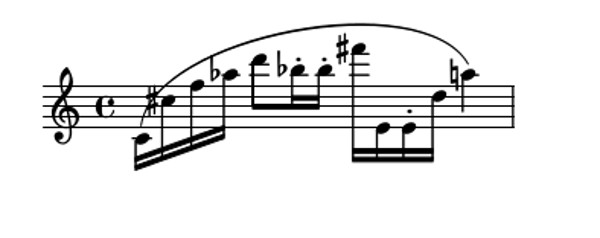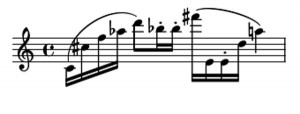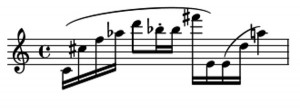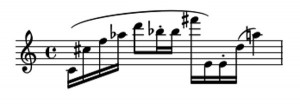This is an imaginary passage I have composed that has annoying and confusing articulation marks.
If you are not a wind player, the fact that this is annoying may puzzle you. It’s like this: as a wind player, from the very beginning you receive strict instructions on the use of the tongue. If there is no slur mark over a note, you initiate the note with the tongue, if it is under a slur mark, you don’t. Simple as that, a digital, on off situation. The passage above, as written, contains too many possibilities for easy reading. It involves guesswork, and that involves time. In some cases, a composer may want to leave the details of articulation up to the player, and that is fine. I enjoy 18th Century repertoire for this reason, and it is perhaps worthwhile for composers to familiarize themselves with what J. J. Quantz has to say about the possibilities of articulation in his treatise On Playing the Flute. (If for nothing else than to understand the weight of history that flutists bear.)
Time spent on interpretive decisions is interesting time.
Time spent on guesswork is not.
This is the 21st Century, and when I see music that is exactly notated, I want to play it exactly, and I want to know what it is I have to say, and how I should say it. Because that is what articulation is all about: how you pronounce your phrase. I want to think that the composer has put some thought into this, as I am putting some practice time into his or her piece.
And, dear composers, please don’t say about a slur: “oh, it’s just a phrase mark.” Really? I am a musician, I make phrases for a living. I don’t need to be told to make one. But I do need to know when to use my tongue and when to hold it. And please don’t just say, “oh, play that legato.” It doesn’t answer my question because I can articulate legato as well as slur something legato. Which should I do? Do you really care?
So if I haven’t pissed you off yet and you really want to see the possibilities for articulating the above passage, here they are.
The first two staccato B-flats are probably meant to be played:
but perhaps the composer meant:
I would really like to be sure.
Now, the two Es, the second one having a staccato, could be played:
But did the composer mean:
well, maybe not, but how can I be sure? So I interrupt practice to contact him or her, or interrupt the rehearsal time to ask, or take time out of the rehearsal break (in which I have twenty other things to get done.)
Several years ago I was working intensely on solo improvisation. I kept a notebook with comments on segments I had recorded. The words SAY SOMETHING DAMMIT were written in block notes at one point. When you listen to music, if it articulates nothing, it says nothing.






Leave a Reply